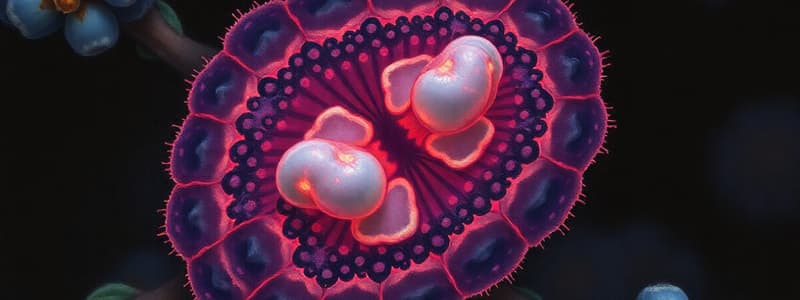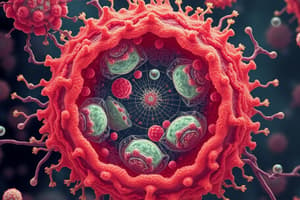Podcast
Questions and Answers
What percentage of lung cancer cases is attributed to smoking?
What percentage of lung cancer cases is attributed to smoking?
- 90% (correct)
- 50%
- 70%
- 100%
Cancer screening prevents cancer from developing.
Cancer screening prevents cancer from developing.
False (B)
Name one common symptom of cancer.
Name one common symptom of cancer.
Fatigue
Screening for colon cancer is often done using ______.
Screening for colon cancer is often done using ______.
Match the following screening methods with their related cancers:
Match the following screening methods with their related cancers:
Which of the following is a recommended lifestyle choice to reduce cancer risk?
Which of the following is a recommended lifestyle choice to reduce cancer risk?
The ABCD of moles includes diameter as one of its criteria.
The ABCD of moles includes diameter as one of its criteria.
Carcinogens in smoke affect more than just the ______.
Carcinogens in smoke affect more than just the ______.
Which imaging technology uses ultra-high frequency sound waves?
Which imaging technology uses ultra-high frequency sound waves?
Cancer cells are always larger than surrounding cells.
Cancer cells are always larger than surrounding cells.
What is one method used to check for leukemia?
What is one method used to check for leukemia?
Chemotherapy can lead to side effects such as ______ and fatigue.
Chemotherapy can lead to side effects such as ______ and fatigue.
Match the cancer treatment with its description:
Match the cancer treatment with its description:
What is a common challenge in treating cancer?
What is a common challenge in treating cancer?
Why might surgery not always be a possible treatment for cancer?
Why might surgery not always be a possible treatment for cancer?
Radiation therapy is directed at the tumor to minimize side effects.
Radiation therapy is directed at the tumor to minimize side effects.
What type of tumor does not affect surrounding cells unless physically crowding them?
What type of tumor does not affect surrounding cells unless physically crowding them?
Malignant tumors grow uncontrollably and can spread to other parts of the body.
Malignant tumors grow uncontrollably and can spread to other parts of the body.
What process occurs when cancer cells break away from the original tumor?
What process occurs when cancer cells break away from the original tumor?
The random changes in DNA that can lead to cancer are known as __________.
The random changes in DNA that can lead to cancer are known as __________.
Which of the following can be a cause of cancer?
Which of the following can be a cause of cancer?
Match the tumor types with their characteristics:
Match the tumor types with their characteristics:
A person can definitely predict their risk of developing cancer based on exposure to carcinogens.
A person can definitely predict their risk of developing cancer based on exposure to carcinogens.
Name one environmental factor that can cause cancer.
Name one environmental factor that can cause cancer.
Flashcards
Metastasis
Metastasis
The process where cancerous cells break away from the original tumor and spread to other parts of the body.
Benign Tumor
Benign Tumor
A tumor that is not cancerous and does not spread to other parts of the body. It can grow, but usually stays contained.
Malignant Tumor
Malignant Tumor
A tumor that is cancerous and can spread to other parts of the body.
Mutation
Mutation
Signup and view all the flashcards
Carcinogens
Carcinogens
Signup and view all the flashcards
Mitosis
Mitosis
Signup and view all the flashcards
Cytokinesis
Cytokinesis
Signup and view all the flashcards
Hereditary Cancer
Hereditary Cancer
Signup and view all the flashcards
X-Ray Imaging
X-Ray Imaging
Signup and view all the flashcards
Ultrasound Imaging
Ultrasound Imaging
Signup and view all the flashcards
CT or CAT Scan
CT or CAT Scan
Signup and view all the flashcards
MRI (Magnetic Resonance Imaging)
MRI (Magnetic Resonance Imaging)
Signup and view all the flashcards
Biopsy
Biopsy
Signup and view all the flashcards
Chemotherapy
Chemotherapy
Signup and view all the flashcards
Radiation Therapy
Radiation Therapy
Signup and view all the flashcards
Surgery
Surgery
Signup and view all the flashcards
Lung Cancer
Lung Cancer
Signup and view all the flashcards
Cancer Screening
Cancer Screening
Signup and view all the flashcards
Endoscopy
Endoscopy
Signup and view all the flashcards
Self-Skin Check
Self-Skin Check
Signup and view all the flashcards
ABCD of Moles
ABCD of Moles
Signup and view all the flashcards
Healthy Lifestyle Choices
Healthy Lifestyle Choices
Signup and view all the flashcards
Preventing Cancer
Preventing Cancer
Signup and view all the flashcards
Study Notes
Cell Division Going Wrong: Cancer
- Cancer cells continue to divide, ignoring signals from the nucleus or surrounding cells to stop.
- Uncontrolled growth and division form a rapidly growing mass called a tumor.
Cell Growth Rates and Cancer
- Normal cells divide a limited number of times (approximately 50-60).
- Cancer cells do not stop reproducing.
- They do not stick to other cells but behave independently.
- They may move to other areas of the body.
- Normal cells have a predictable size and shape.
- Cancer cells can be larger or smaller and have irregular shapes.
- They are disorganized in arrangement.
Normal Cells vs. Cancerous Cells
- Normal cells have a defined shape and size; cancerous cells vary.
- Normal cells stay close together; cancerous cells may cluster without boundaries.
- Normal cells' nuclei are not noticeably larger or darker than others within the sample.
- Cancer cells' nuclei are larger and darker.
Normal Cell vs. Cancer Cell Comparison
- Normal Cell: Makes exact copies through mitosis; stops reproducing after a certain number of divisions; sticks together in masses; self-destructs when damaged.
- Cancer Cell: Makes exact copies through mitosis; does not stop reproducing; does not stick to other cells; may move to another location in the body.
Normal vs. Cancer Cell (Diagrammatic Representation)
- Diagram showing normal cell division versus uncontrolled cell division that leads to cancer.
- Diagram displaying apoptosis (cell death) in healthy cells, a process absent in cancerous cells
Benign vs. Malignant Tumors
- Benign: Tumor cells grow only in one area and do not spread.
- Malignant: Tumor cells invade surrounding tissues, enter blood vessels, and metastasize.
Cell Growth Rates and Cancer (Benign vs. Malignant Tumors)
- Benign Tumor: Cells remain localized, do not spread, and do not cause serious damage beyond tissue crowding.
- Malignant Tumor: Cells invade and destroy surrounding tissues, producing enzymes and hormones that interfere with normal function.
Metastasis
- Metastasis is the spread of cancer cells from the original tumor to other parts of the body.
- Cancer cells break away from the original tumor and move to a new location.
- Cancer cells grow and divide uncontrollably forming a new tumor in the new location.
Causes of Cancer
- DNA duplication happens every time a cell divides.
- Genetic information is usually identical between the parent cell and the daughter cell, except for occasional random changes called mutations in the DNA.
- Mutations can lead to cancerous behavior in cells.
- Cancer is caused by carcinogens (environmental factors).
- Carcinogens include tobacco smoke, radiation, viruses, chemicals in plastics, and organic solvents.
- Inherited DNA sometimes enables cancer due to susceptibility factors passed through generations.
- Genetic predisposition increases but is not a definite guarantee for the development of a specific type of cancer
Smoking and Cancer
- Smoking is a significant cause of lung cancer, affecting 90% of cases in people over 40 in Canada.
- Carcinogens in smoke harm lung tissues.
- Avoiding smoking and second-hand smoke helps prevent smoking-related cancers.
Cancer Screening
- Cancer screening is checking for cancer even when no symptoms are present.
- Screening can be home-based or physician-led.
- It's crucial for individuals with a family history of specific cancers (e.g., breast or colon cancer).
- Genetic screening helps determine inherited DNA susceptibility to cancer.
- Screening increases cancer detection chances for early treatment.
Taking Responsibility for Your Health
- Women: Regular breast self-exams, Pap tests for cervical cancer.
- Men: Testicular self-exams, PSA test for prostate cancer (after age 50).
- Blood tests for colon cancer; regular skin checks by doctor/dermatologist; checking own skin for moles by using the ABCD of moles (Asymmetry, Border, Colour, Diameter).
Reducing Risk of Cancer
- Prevention and early detection are crucial.
- A healthy lifestyle is beneficial: plenty of fruits, vegetables, less fatty meats, and certain "superfoods"; maintain a healthy weight and exercise regularly.
Diagnosing Cancer
- Possible symptoms of cancer include swelling, discomfort, fatigue, and unexplained weight loss.
- Early diagnosis improves treatment success chances.
Imaging Technologies
- Endoscopy: Sedated patient for colon cancer screening; fiber optic cable with camera viewing the colon through rectum.
- X-Ray: Images internal body parts (bones, lungs); can cause DNA damage to rapidly dividing cells (fetuses, or rapidly growing cancers).
- Ultrasound: Uses high-frequency sound waves to view soft tissues (e.g., heart, liver).
- CT (Computerized Axial Tomography): Multiple x-ray images from various angles to create internal body images.
- MRI (Magnetic Resonance Imaging): Radio waves and strong magnetic fields produce detailed images, more accurate than CT scans.
Examining Cells
- Blood samples viewed under a microscope reveal cellular pathologies, e.g., high white blood cell count indicating leukemia.
- Tumor cells collected via biopsy reveal genetic abnormalities; viewed under microscope for characteristic cellular behaviors and cellular abnormalities
- Diagnostic assessments include the origin, size, growth rate, and spread of tumor.
Treatment for Cancer
- Surgery: Physically removes cancerous tissue, effective when the tumor is accessible and defined.
- Chemotherapy: Drugs injected or taken orally slow or stop cancer cell division; killing cancerous cells. Includes potential side effects (hair loss, nausea, fatigue.) Effectiveness often outweighs side effects.
- Radiation: Ionizing radiation damages DNA in cancer cells, preventing further division. Concentrates radiation at tumors, minimizing effect on healthy regions.
- Biophotonics: Uses light beams to detect and treat cancer; sensitive diagnosis of early cancer and fewer side effects compared to conventional radiation. Targets cancerous cells more precisely.
- Genomics: Identifies gene mutations driving the cancer, enabling more personalized and effective treatment plans with a focus on genes affected rather than solely organs.
Studying That Suits You
Use AI to generate personalized quizzes and flashcards to suit your learning preferences.
Related Documents
Description
This quiz explores the differences between normal cells and cancer cells, focusing on their growth rates, division patterns, and structural characteristics. Understand how cancer cells defy the usual constraints of cell division, leading to tumor formation and disrupted body functions.




